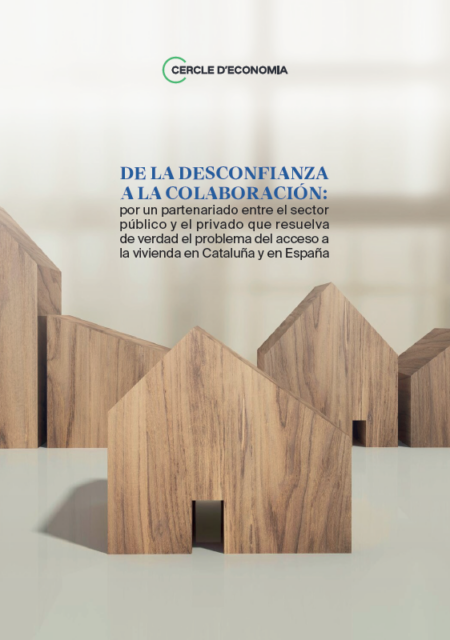

Cercle d'Economia warns that, in Spain and Catalonia, as in many other places in Europe, access to housing is a major social and economic problem that particularly affects the most vulnerable and young people. A problem that has been going on for a long time and has been alarmingly accentuated in recent years.
Cercle d'Economia recalls that the inevitable starting point must be the recognition that there are no miraculous or immediate solutions. The accumulated deficits are too large to think that all, or even a significant part of the problem, will be solved in the short term. On the contrary, it will take time, and that is why it is very important that the policies that are implemented are long-term and last over time.
Cercle d'Economia stresses that the measures that are implemented must respond to a triple principle. First, they should focus on increasing the supply of rental housing, both subsidised and market, because this is the great deficit that housing policy has accumulated in recent decades. Second, housing policies should be channelled preferably through public spending rather than through regulation, as has been the case until now. And third, that housing policy is based on consultation between the public and private sectors, in which the former sets incentives and provides resources and the latter undertakes to collaborate actively in exchange for a reasonable return.
To deal in the short term with the emergency affecting families with fewer resources, Cercle proposes to introduce the figure of subsidized arranged rent for vulnerable families or individuals, who have been evicted or who are at risk of eviction. This is a measure that could be implemented immediately and that would allow cases of extreme vulnerability to be dealt with without the need to wait for the construction of more protected housing stock.
Cercle also proposes establishing a mechanism of public guarantees for the collection of rents. The private sector (individuals, real estate developers and the financial sector) cannot and should not bear the risk of non-payment of rent. It is the State that must protect the most vulnerable families and individuals. In this way, the legal certainty of contracts would be reinforced and many of the problems posed by the eviction system provided for in the law would be overcome.
Likewise, to increase the supply of housing, mainly for rent, Cercle suggests not applying the regulation of the rental price provided for in the law. He considers that if one of the key objectives to improve access to housing is to increase the supply of free rental housing, regulating its price does not seem to be the best way to achieve this. It is known that the regulation of rental prices discourages supply in the long term (not only by preventing it from increasing, but eventually by causing it to decrease) and in the short term it has very pernicious effects such as the conversion of regular rentals into informal modalities (room rentals, seasonal rentals, etc.) that are detrimental to actual and potential tenants. The regulation of rents is also inefficient, because it hardly discriminates, and it is regressive, because it can end up lowering the price of many tenants who can pay the market rent without problems. It would therefore be advisable to propose a change in the law on this point, because otherwise it will be very difficult for the private initiative to invest in renting or for individuals who have flats to put them on the market to rent them.
It also proposes to establish public aid mechanisms for the rehabilitation of homes so that they are used exclusively for rent. These measures may consist of tax rebates and/or subsidies on interest on loans or guarantees on loans intended to finance these renovations, always conditional on the refurbished housing remaining on the rental market for a reasonable period, for example ten or fifteen years.
It also proposes to facilitate and speed up changes of use in a double area: on the one hand, in terms of obtaining the certificate of occupancy in the changes of use of premises or studies because the urban action has prescribed; on the other hand, in terms of urban planning licenses for the change of use of buildings already built currently intended for offices or services. Both measures could be immediate, because in the first case they are written and registered without the need for a licence, and in the second case it would not be necessary to modify the planning if they are in areas where there is unexecuted buildability intended for housing (such as 22@, for example).
It also indicates the possibility of agreeing with SAREB, which has already become a public company, to stop the sale of its homes and put them on social and affordable rent, managed directly by it itself or in agreement with the autonomous communities.
It also proposes to make building land available. Facilitating the change of uses, allowing, for example, that land for facilities that are known not to be built can be changed to residential land. This is a mechanism that can be used to mobilise a significant amount of land and, moreover, it is a mechanism that is not complex from a procedural point of view, and that would therefore have an immediate effect. Also by making urban planning more flexible and increasing the provision of residential land, both public and private.
On the other hand, Cercle suggests making the application of inclusive zoning provisions more flexible (40% quota for subsidised housing, with 50% dedicated to rent) to ensure the interest of developers and avoid failures such as that of the city of Barcelona, where very restrictive regulations in this area have led to the construction of barely a hundred subsidised homes in the last eight years. In addition, it proposes to increase the buildability coefficient in certain developments, linking it to the construction of social housing. A fact that would be a fertile element for the promoters and would not require additional public resources.
In the medium term, Cercle suggests building a large stock of subsidized housing through public-private collaboration on public land ceded to private developers over a long period of time (sixty-five years, for example). They would build subsidized rental housing to which families or individuals would have access at appraised prices, below the market, and following the conditions established by the corresponding administration. The risk of this initiative would correspond to private investors. The management of this housing stock would be entrusted to a private rental manager or a non-profit entity. This scheme is already being implemented in Madrid (Plan VIVE) and Barcelona (Plan Metropolis). The construction of this protected housing stock requires public aid so that the private sector is actively involved and accepts the risk involved in an initiative of this type. This aid can take different forms, whether it is subsidies for construction costs or interest rates. The value of the modules (which in many cases have not been updated for many years despite the cost inflation that has occurred during this time) could also be increased.
It also proposes to expand the assumptions and speed up the urban planning licenses for the change of uses of buildings already built currently intended for offices or services, if a modification of the planning is necessary because they are in areas where the density of housing was already absorbed by the existing building.
It also suggests promoting a metropolitan vision of housing policy in Spain, considering the serious inefficiencies that exist in land management, as the OECD warns. This is especially relevant in the case of metropolitan Barcelona, given the scarcity of available land in the city.
Finally, as complementary measures, Cercle is committed to a great pact for housing since, if there is really to be a long-term housing policy that solves the serious problem of access to housing in Catalonia and Spain, it is essential that the different actors involved - public and private - agree on objectives, a strategy and an action plan. This pact should include the three administrations (central, regional and local) and the large private actors (financial sector, large owners, developers) and ideally the main political parties. This pact should cover the largest number of areas proposed above.
It is also committed to encouraging the purchase of housing for young people, thus freeing up housing that would increase the rental supply, applying the reduced rate of the ITP (from 10% to 5% in the case of Catalonia) for young people under forty years of age and with a net income of less than sixty thousand euros, for example, and guaranteeing the administration part of the mortgage loan for the acquisition of the first home (similar to the ICO loans approved during the pandemic of COVID-19).